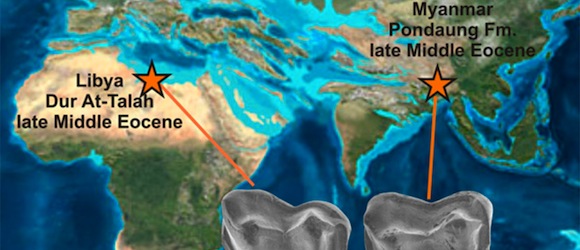It’s been a generally established in the scientific community that the earliest apes to start walking on two legs, the ancestors of humanity, used their newly acquired talent while walking around Africa. But about twenty years ago, fossils that once were the bony parts of tiny primates began to be found in China, Myanmar, and other places on the Asian continent. What it looked like was that the simian family had actually been evolving in Asia, and at some point members of it migrated to Africa and eventually gave rise to homo sapiens, but while there was fossil evidence in Asia and Africa, there wasn’t enough to show which species had migrated or when.
But a new find by a group of international researchers, who’ve labored in Myanmar for six years to find four teeth of a tiny, chipmunk-sized simian ancestor, purports to have filled that gap.
The four molars belong to the new species Afrasia djijidae, and have been found to be closely related to another species that has been dated to about the same time… except the second species lived in Africa, continents away from A. djijidae. From Wired:
When the researchers examined the teeth from the two primates under a microscope, they were so similar in size, shape, and age that they could have belonged to the same species of primate, says Beard. Such close resemblance between an Asian and African fossil anthropoid has “never been demonstrated previously,” the authors write online today in the Proceedings of the National Academy of Sciences.
On closer examination, however, the team noticed that the new molars from the Asian Afrasia were more primitive than those of Afrotarsius from Libya, particularly in the larger size of a tiny bulge at the back of its last lower molar. These primitive traits, as well as the greater diversity and age of early, or “stem,” anthropoids in Asia rather than Africa suggest that this group arose in Asia and migrated to Africa 37 million to 39 million years ago…
“If proven, the biogeographical significance of these results is profound,” says paleontologist Richard Kay of Duke University in Durham, North Carolina. It would show that there was a major migration of primates and probably other mammals between the two continents at a time when it was not easy to get across the ancient Tethys Sea that divided Africa from Asia. And for humans, it would suggest that our deepest primate roots were in Asia, not Africa.
A. Djijidae was likely not the only primate that made the migration, since there a number of primate species known to have lived in Africa at the same time that are not similar. Likely they are descended from other migrating species. Possibly Cylons.
(via Wired.)








Published: Jun 7, 2012 8:32 PM UTC